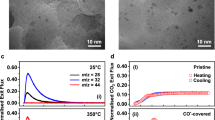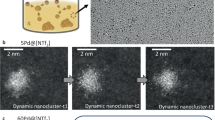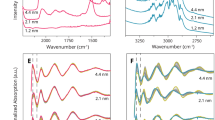Abstract
The quantitative prediction of catalyst selectivity is essential to the design of efficient catalytic processes and requires a detailed knowledge of the reaction mechanism and rate constants. Here we present a study that accurately predicts, using the kinetics and a mechanism derived from fundamental studies on single-crystal gold, the product distribution resulting from the complex reaction network that governs the oxidative coupling of methanol, catalysed by nanoporous gold between 360 and 425 K and for a vast range of pressures. Analysis of the transient product responses to micropulses of methanol over nanoporous gold yields a precise understanding of the marked dependence of selectivity on pressure, surface oxygen coverage and temperature. The key to a high selectivity for methyl formate is the surface lifetime and abundance of the methoxy. This successful microkinetic modelling of catalytic reactions across a wide set of reaction conditions is broadly applicable to predicting catalytic selectivity and provides a pathway to designing more efficient catalytic processes.
This is a preview of subscription content, access via your institution
Access options
Access Nature and 54 other Nature Portfolio journals
Get Nature+, our best-value online-access subscription
$29.99 / 30 days
cancel any time
Subscribe to this journal
Receive 12 digital issues and online access to articles
$119.00 per year
only $9.92 per issue
Buy this article
- Purchase on Springer Link
- Instant access to full article PDF
Prices may be subject to local taxes which are calculated during checkout







Similar content being viewed by others
Data availability
The data that support the plots within this paper and other findings of this study are available from the corresponding author upon reasonable request.
References
Holdren, J. P. Materials Genome Initiative for Global Competitiveness (National Science and Technology Council, Washington DC, 2011).
Hattrick-Simpers, J., Wen, C. & Lauterbach, J. The materials super highway: integrating high-throughput experimentation into mapping the catalysis materials genome. Catal. Lett. 145, 290–298 (2015).
Nørskov, J. K., Bligaard, T., Rossmeisl, J. & Christensen, C. H. Density functional theory in surface chemistry and catalysis. Nat. Chem. 1, 37–46 (2009).
Nørskov, J. K., Abild-Pedersen, F., Studt, F. & Bligaard, T. Density functional theory in surface chemistry and catalysis. Proc. Natl Acad. Sci. USA 108, 937–943 (2011).
Xu, J. G. & Froment, G. F. Methane steam reforming, methanation and water–gas shift .1. Intrinsic kinetics. AIChE J. 35, 88–96 (1989).
Gleaves, J. T., Ebner, J. R. & Kuechler, T. C. Temporal analysis of products (TAP)—a unique catalyst evaluation system with submillisecond time resolution. Catal. Rev. 30, 49–116 (1988).
Stahl, S. S. Palladium-catalyzed oxidation of organic chemicals with O2. Science 309, 1824–1826 (2005).
Sheldon, R. A. in Heterogeneous Catalysis and Fine Chemicals II, Vol. 59 (eds Guisnet, M. et al.) 33–54 (Studies in Surface Science and Catalysis Vol. 59, Elsevier, Amsterdam, 1991).
Sheldon, R. A. Catalytic oxidations in the manufacture of fine chemicals. Stud. Surf. Sci. Catal. 55, 1–32 (1990).
Xu, B. & Friend, C. M. Oxidative coupling of alcohols on gold: insights from experiments and theory. Faraday Discuss. 152, 307 (2011).
Stowers, K. J., Madix, R. J. & Friend, C. M. From model studies on Au(111) to working conditions with unsupported nanoporous gold catalysts: oxygen-assisted coupling reactions. J. Catal. 308, 131–141 (2013).
Xu, B., Haubrich, J., Baker, T. A., Kaxiras, E. & Friend, C. M. Theoretical study of O-assisted selective coupling of methanol on Au(111). J. Phys. Chem. C 115, 3703–3708 (2011).
Wachs, I. E. & Madix, R. J. The surface intermediate H2COO. Appl. Surf. Sci. 5, 426–428 (1980).
Outka, D. A. & Madix, R. J. Acid–base and nucleophilic chemistry of atomic oxygen on the Au(110) surface: reactions with formic acid and formaldehyde. Surf. Sci. 179, 361–376 (1987).
Xu, B., Liu, X., Haubrich, J., Madix, R. J. & Friend, C. M. Selectivity control in gold-mediated esterification of methanol. Angew. Chem. Int. Ed. 48, 4206–4209 (2009).
Xu, B., Madix, R. J. & Friend, C. M. Predicting gold-mediated catalytic oxidative-coupling reactions from single crystal studies. Acc. Chem. Res. 47, 761–772 (2014).
Sexton, B. A. & Madix, R. J. A vibrational study of formic acid interaction with clean and oxygen-covered silver (110)surfaces. Surf. Sci. 105, 177–195 (1981).
Personick, M. L. et al. Ozone-activated nanoporous gold: a stable and storable material for catalytic oxidation. ACS Catal. 5, 4237–4241 (2015).
Sault, A. G., Madix, R. J. & Campbell, C. T. Adsorption of oxygen and hydrogen on Au(110)-(1 × 2). Surf. Sci. 169, 347–356 (1986).
Meyer, R., Lemire, C., Shaikhutdinov, S. K. & Freund, H.-J. Surface chemistry of catalysis by gold. Gold Bull. 37, 72–124 (2004).
Wittstock, A. et al. Nanoporous Au: an unsupported pure gold catalyst? J. Phys. Chem. C 113, 5593–5600 (2009).
Wittstock, A. et al. Nanoporous gold catalysts for selective gas-phase oxidative coupling of methanol at low temperature. Science 327, 319–322 (2010).
Getman, R. B., Yu, Y. & Schneider, W. F. Thermodynamics of environment-dependent oxygen chemisorption on Pt(111). J. Phys. Chem. C 112, 9559–9572 (2008).
Mulla, S. S., Chen, N., Delgass, W. N., Eppling, W. S. & Ribeiro, F. H. NO2 inhibits the catalytic reaction of NO and O2 over Pt. Catal. Lett. 200, 267–270 (2005).
Zugic, B. et al. Dynamic restructuring drives catalytic activity on nanoporous gold–silver alloy catalysts. Nat. Mater. 16, 558–564 (2016).
Redhead, P. A. Thermal desorption of gases. Vacuum 12, 203–211 (1962).
Falconer, J. L. & Madix, R. J. Flash desorption activation energies: DCOOH decomposition and CO desorption from Ni(110). Surf. Sci. 48, 393–405 (1975).
Gleaves, J. J. T., Yablonskii, G. G. S., Phanawadee, P. & Schuurman, Y. TAP-2: an interrogative kinetics approach. Appl. Catal. A 160, 55–88 (1997).
Shekhtman, S. O., Yablonsky, G. S., Chen, S. & Gleaves, J. T. Thin-zone TAP-reactor—theory and application. Chem. Eng. Sci. 54, 4371–4378 (1999).
Shekhtman, S. O., Yablonsky, G. S., Gleaves, J. T. & Fushimi, R. R. Thin-zone TAP reactor as a basis of "state-by-state transient screening". Chem. Eng. Sci. 59, 5493–5500 (2004).
Yablonsky, G. S., Olea, M. & Marin, G. B. Temporal analysis of products: basic principles, applications, and theory. J. Catal. 216, 120–134 (2003).
Shekhtman, S. O., Yablonsky, G. S., Gleaves, J. T. & Fushimi, R. ‘State defining’ experiment in chemical kinetics—primary characterization of catalyst activity in a TAP experiment. Chem. Eng. Sci. 58, 4843–4859 (2003).
Gleaves, J. T., Yablonsky, G., Zheng, X., Fushimi, R. & Mills, P. L. Temporal analysis of products (TAP)—recent advances in technology for kinetic analysis of multi-component catalysts. J. Mol. Catal. A 315, 108–134 (2010).
Constales, D., Yablonsky, G. S., Marin, G. B. & Gleaves, J. T. Multi-zone TAP-reactors theory and application: I. The global transfer matrix equation. Chem. Eng. Sci. 56, 133–149 (2001).
Campbell, C. T. The degree of rate control: a powerful tool for catalysis research. ACS Catal. 7, 2770–2779 (2017).
Xu, B., Madix, R. J. & Friend, C. M. Achieving optimum selectivity in oxygen assisted alcohol cross-coupling on gold. J. Am. Chem. Soc. 132, 16571–16580 (2010).
Stoltze, P. Microkinetic simulation of catalytic reactions. Prog. Surf. Sci. 65, 65–150 (2000).
Salciccioli, M., Stamatakis, M., Caratzoulas, S. & Vlachos, D. G. A review of multiscale modeling of metal-catalyzed reactions: mechanism development for complexity and emergent behavior. Chem. Eng. Sci. 66, 4319–4355 (2011).
MATLAB—MathWorks (The Mathworks, 2016); http://www.mathworks.com/products/matlab/
Wang, L.-C. et al. Active sites for methanol partial oxidation on nanoporous gold catalysts. J. Catal. 344, (2016).
Acknowledgements
This work was supported as part of the Integrated Mesoscale Architectures for Sustainable Catalysis (IMASC), an Energy Frontier Research Center funded by the US Department of Energy (DOE), Office of Science, Basic Energy Sciences (BES), under Award no. DE-SC0012573. E.A.R. expresses his gratitude to U. Olsbye for her support and enthusiasm about applying TAP for mechanistic research in catalysis. E.A.R. acknowledges the Norwegian Research Council for financial support through contract 239193.
Author information
Authors and Affiliations
Contributions
R.J.M. and E.A.R. guided the research. C.R. and S.K. performed the experiments. C.R. performed the microkinetic modelling. R.J.M., C.R, E.A.R., S.K. and C.M.F. all participated in frequent discussions and contributed significantly to writing the manuscript.
Corresponding author
Ethics declarations
Competing interests
The authors declare no competing interests.
Additional information
Publisher’s note: Springer Nature remains neutral with regard to jurisdictional claims in published maps and institutional affiliations.
Supplementary information
Supplementary Information
Supplementary Notes 1–8, Supplementary Figures 1–5, Supplementary Tables 1–4 and Supplementary References
Rights and permissions
About this article
Cite this article
Reece, C., Redekop, E.A., Karakalos, S. et al. Crossing the great divide between single-crystal reactivity and actual catalyst selectivity with pressure transients. Nat Catal 1, 852–859 (2018). https://doi.org/10.1038/s41929-018-0167-5
Received:
Accepted:
Published:
Issue Date:
DOI: https://doi.org/10.1038/s41929-018-0167-5
This article is cited by
-
Interrogating site dependent kinetics over SiO2-supported Pt nanoparticles
Nature Communications (2024)
-
Identifying and avoiding dead ends in the characterization of heterogeneous catalysts at the gas–solid interface
Nature Catalysis (2023)
-
Following the structure of copper-zinc-alumina across the pressure gap in carbon dioxide hydrogenation
Nature Catalysis (2021)
-
The kinetics of elementary thermal reactions in heterogeneous catalysis
Nature Reviews Chemistry (2019)
-
Mind the gap
Nature Catalysis (2018)



